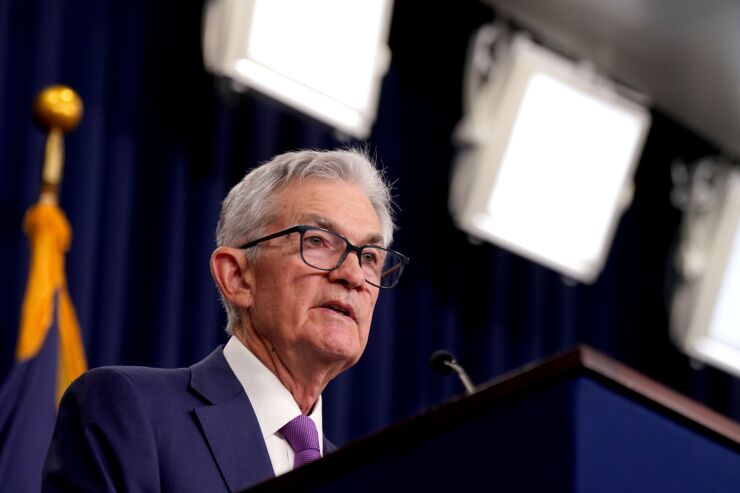
A resilient economy and continued strong employment gains could persuade the Federal Reserve to keep
The one-two punch of slower lending and higher funding expenses crimped many banks' net interest margins and, by extension, fourth-quarter profits. Bankers said during earnings season in January and early this month that they
The $61 billion-asset Valley National in New York, for example, said its fourth-quarter NIM fell 9 basis points from the prior quarter and plunged 75 basis points from a year earlier to 2.82%.
Valley Chairman and CEO Ira Robbins said on the company's earnings call that "it's a
Last Wednesday, Fed policymakers left their benchmark rate untouched — as they have since last summer — after boosting it at the fastest pace in 40 years between March 2022 and July 2023, to a range of 5.25% and 5.5%. The Fed forced rates higher to curb inflation that soared above 9% in 2022 and reached the highest level of this century. The Fed proved largely successful: The inflation rate fell to 3.4% at the end of last year.
Still, inflation continues to hover well above the Fed's preferred 2% rate. What's more, the strength of the job market and continued economic growth could reignite robust consumer spending and price spikes, Fed Chair Jerome Powell cautioned at a news conference.
"We've made a lot of progress on inflation," he said. "We just want to make sure that we do get the job done in a sustainable way."
Ahead of the
Then, on Friday of last week, the Labor Department affirmed that the employment picture continues to brighten, following robust gains over the course of 2023. It said employers
The economy advanced at a 3.3% annual rate in the fourth quarter, following growth in the third quarter of 4.9%, according to federal data. The January job gains keep the economy on a solid growth path, economists said.
"The January jobs report was impressively strong" and likely pushes until at least May the first Fed rate cut, said Carl Riccadonna, BNP Paribas' chief U.S. economist.
In an
Continued bullish employment data, and any reversal in the inflation trajectory, could further delay rate reductions. That could continue to pressure regional and community banks' deposit expenses and, following hits to profitability in the second half of 2023, extend the bruising further into this year, analysts said.
Cooled inflation "could mean that U.S. policymakers manage to land the economy without too much turbulence — but we're miles away from knowing that for sure," said Sophie Lund-Yates, lead equity analyst at Hargreaves Lansdown. "For now, it seems likely the economy has a touch too much wind in its sails for the Federal Reserve to change course."
That leaves banks in wait-and-see mode.
First Foundation in Dallas, which has faced
Its NIM shriveled to 1.36% from 1.66% the prior quarter and 2.45% a year earlier.
For First Foundation, "there's probably, I would say, upward towards $3 billion of liabilities that would reprice immediately if the Fed were to cut rates, which would be a substantial savings and, frankly, ignite earnings back to where they once were," President and CEO Scott Kavanaugh said on the bank's earnings call.
While the bank expects improvement this year should the Fed's target rate hold steady, Kavanaugh added, "obviously, it won't be at the same pace as if the Fed were to start cutting."
Even if the Fed does lower rates multiple times this year, as many banks anticipate, NIM expansion is likely to prove a long, gradual process.
Sandy Spring Bancorp Chairman and CEO Daniel Schrider said during the company's earnings call that he anticipates three rate cuts in the second half of this year and more in 2025. Should those expectations prove correct, he said the bank's margin could recover to 2022 levels late in 2025.
The $14 billion-asset bank in Olney, Maryland, said its NIM of 2.45% for the fourth quarter compared to 2.55% for the previous quarter and 3.26% for the final quarter of 2022.
Should the Fed push rates lower, "we expect the margin to bottom out in the first quarter" and "then to rebound in the second quarter and throughout the remainder of the year, by 7 to 10 basis points per quarter. We would also expect the Fed to continue rate cuts throughout 2025, which would allow the margin to move above 3% during the second half of next year."






